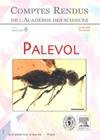阿根廷西北部Chañares组(晚三叠世)原蕨科的组织变异和生活方式,1966(始龙目)
IF 1.3
4区 地球科学
Q3 PALEONTOLOGY
引用次数: 0
摘要
本文报道了基于尾骨的Chañares组(卡尼期早期)元champides的古组织学新数据,特别是Chanaresuchus bonapartei Romer, 1971(即PULR-V 116,股骨,胫骨和腓骨)和Tropidosuchus romeri Arcucci, 1990(即PVL-4606,股骨),并为其古生物学,组织变异性和生活方式提供了新的见解。波拿巴Chanaresuchus bonapartei具有种内和元素间的组织变异性,骨组织中胶原纤维由板层组织到编织纤维组织,血管密度由稀疏到致密。两个标本似乎都达到了性成熟和骨骼成熟,但无法推断体细胞成熟。罗氏棘豆呈种内组织变异性,骨组织中胶原纤维由平行纤维组织到编织纤维组织,并有致密的血管化。对T. romeri的生活方式进行了分析,使用了一个结合了解剖学和微观解剖学数据的统计模型,表明这是一种陆地习惯。从Chañares组中发现的原蕨科(Proterochampsidae Romer, 1966)在同一分类群的个体之间以及与其他同时期的始祖形动物相比,表现出很大的生长策略差异。本文章由计算机程序翻译,如有差异,请以英文原文为准。
Histovariability and lifestyle in Proterochampsidae Romer, 1966 (Archosauriformes) from the Chañares Formation (Late Triassic), northwestern Argentina
This present work reports new data on the palaeohistology of Chañares Formation (early Carnian) proterochampsids based on appendicular bones, particularly Chanaresuchus bonapartei Romer, 1971 (i.e., PULR-V 116, femur, tibia and fibula) and Tropidosuchus romeri Arcucci, 1990 (i.e., PVL-4606, femur), and provides new insights into their paleobiology, histovariability, as well as lifestyle. Chanaresuchus bonapartei presents intraspecific and interelemental histovaribility with collagen fibers organized from lamellar to woven fibered bone tissue, and degree of vascular density from sparse to dense. Both specimens appear to have attained sexual and skeletal maturity, but somatic maturity could not be inferred. Tropidosuchus romeri presents intraspecific histovaribility with collagen fibers organized from parallel-fibered to woven fibered bone tissue, and dense vascularization. The lifestyle analysis for T. romeri, using a statistical model that employs anatomical and microanatomical data, suggests a terrestrial habit. The Proterochampsidae Romer, 1966 recovered from the Chañares Formation exhibits a large disparity in growth strategies among individuals of the same taxa, and with respect to other contemporaneous Archosauriformes.
求助全文
通过发布文献求助,成功后即可免费获取论文全文。
去求助
来源期刊

Comptes Rendus Palevol
地学-古生物学
CiteScore
2.10
自引率
0.00%
发文量
39
审稿时长
17.6 weeks
期刊介绍:
Comptes Rendus Palevol is a fully electronic and peer-reviewed journal, with a continuous publication stream, devoted to palaeontology, prehistory and evolutionary sciences. It publishes original research results, in French or English, in the following domains: systematic and human palaeontology, prehistory, evolutionary biology and macroevolution, and history of sciences. Thematic issues may also be published under the responsibility of a guest editor. All articles published in Comptes Rendus Palevol are compliant with the different nomenclatural codes. A copyright assignment will be signed by the authors before publication.
 求助内容:
求助内容: 应助结果提醒方式:
应助结果提醒方式:


